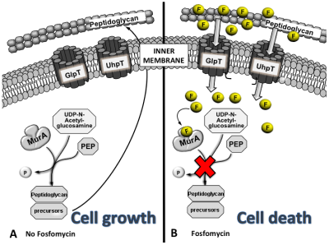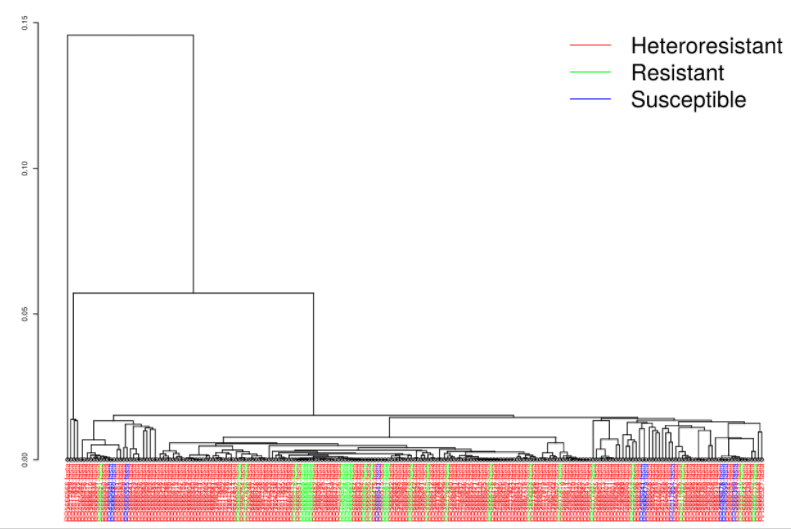Team II Comparative Genomics Group: Difference between revisions
| Line 46: | Line 46: | ||
We executed a pan-genome GWAS using the tool 'bacterial GWAS'. Bacterial GWAS runs prodigal on assembled contigs to annotate ORFs, and performs CD-HIT clustering to construct a pan-genome. Then it performs a GWAS using a logistic regression model on the given phenotypes - presence or absence of heteroresistance and outputs a list of significant predicted genes along with the frequency of their occurrence in each phenotype. We then BLASTed the predicted genes to identify their function. | We executed a pan-genome GWAS using the tool 'bacterial GWAS'. Bacterial GWAS runs prodigal on assembled contigs to annotate ORFs, and performs CD-HIT clustering to construct a pan-genome. Then it performs a GWAS using a logistic regression model on the given phenotypes - presence or absence of heteroresistance and outputs a list of significant predicted genes along with the frequency of their occurrence in each phenotype. We then BLASTed the predicted genes to identify their function. | ||
[[File: | [[File:Trait_0_SNP_logreg_manhattan.png|frame|none|Fig #: A manhattan plot where each point represents a single predicted gene feature]] | ||
==Phylogeny Approach== | ==Phylogeny Approach== | ||
Revision as of 19:10, 15 April 2018
Introduction
Background
Comparative genomics is the study of comparing genome sequences to better understand the structure and function of genes.
Fosfomycin
Fosfomycin is a natural antibacterial produced by various Streptomyces and Pseudomonas species. It is the only antibiotic currently in clinical use that targets a Mur enzyme. It is broad-spectrum bactericidal antibiotic that can be employed against both Gram-positive and Gram-negative bacteria. It interferes with cell wall synthesis, particularly inhibits the initial step involving phosphoenolpyruvate synthetase, as shown below.

Resistance of Fosfomycin involves a wide range of resistance mechanisms. Some of them include reduced uptake, target site modification, expression of antibiotic-degrading enzymes and rescue of the UDP-MurNAc biogenesis pathway (ex. mutation within MurA enzyme).
Objectives
To identify genetic determinants that could be a potential cause for Fosfomycin heteroresistance in the isolates provided.
Data
The following is the metadata of our study:

Whole Genome Approach
The Whole Genome approach to comparative genomics attempts to broadly identify similarities and differences across samples.
Similarity analysis
Identifying similarities among our samples would tell us if phenotypic similarities correlate with overall genome similarity and help us choose representatives.
We computed min-hash distances between all samples with known Antibiotic resistance phenotype and clustered them using complete linkage hierarchical clustering.

The dendrogram indicates that there is no clear demarcation between the different resistance phenotypes, confirming that there is no broad genomic signature that distinguishes the heteroresistant samples from the non-heteroresistant samples.
After removing the outliers, we found a single highly similar cluster of isolates that spanned all 3 phenotypes (Resistant, heteroresistant, susceptible)

These 11 samples have relative mash distances =~ 0.0001, suggesting that any genetic element causing the different antibiotic resistance phenotypes would be caused by the extremely small percentage of differences between these samples. We believe this cluster is a good representative of our complete dataset.
Difference analysis
In order to identify the genomic differences between our samples, we decided to perform a Genome Wide Association Study or GWAS. A GWA study correlates the presence or absence of variants in a genome with the presence or absence of a trait, which in our case is heteroresistance.
We executed a pan-genome GWAS using the tool 'bacterial GWAS'. Bacterial GWAS runs prodigal on assembled contigs to annotate ORFs, and performs CD-HIT clustering to construct a pan-genome. Then it performs a GWAS using a logistic regression model on the given phenotypes - presence or absence of heteroresistance and outputs a list of significant predicted genes along with the frequency of their occurrence in each phenotype. We then BLASTed the predicted genes to identify their function.

Phylogeny Approach
Results and Discussion
References
Castañeda-García, Alfredo, Jesús Blázquez, and Alexandro Rodríguez-Rojas. "Molecular mechanisms and clinical impact of acquired and intrinsic fosfomycin resistance." Antibiotics 2.2 (2013): 217-236.
Nikolaidis I, Favini-Stabile S, Dessen A. 2014. Resistance to antibiotics targeted to the bacterial cell wall. Protein Sci 23: 243–259.
Kidd, Timothy J et al. “A Klebsiella Pneumoniae Antibiotic Resistance Mechanism That Subdues Host Defences and Promotes Virulence.” EMBO Molecular Medicine 9.4 (2017): 430–447.
Guo, Qinglan et al. “Glutathione-S-Transferase FosA6 of Klebsiella Pneumoniae Origin Conferring Fosfomycin Resistance in ESBL-Producing Escherichia Coli.” Journal of Antimicrobial Chemotherapy 71.9 (2016): 2460–2465.
Gardner, Shea N., Tom Slezak, and Barry G. Hall. "kSNP3. 0: SNP detection and phylogenetic analysis of genomes without genome alignment or reference genome." Bioinformatics31.17 (2015): 2877-2878.
Shea N Gardner, Tom Slezak, Barry G. Hall; kSNP3.0: SNP detection and phylogenetic analysis of genomes without genome alignment or reference genome, Bioinformatics, Volume 31, Issue 17, 1 September 2015, Pages 2877–2878.
Kim, Mincheol, et al. "Towards a taxonomic coherence between average nucleotide identity and 16S rRNA gene sequence similarity for species demarcation of prokaryotes." International journal of systematic and evolutionary microbiology 64.2 (2014): 346-351.